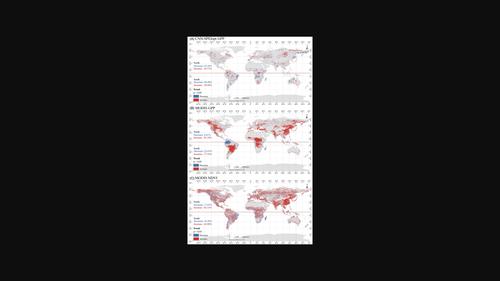当前位置:
X-MOL 学术
›
Remote Sens. Ecol. Conserv.
›
论文详情
Our official English website, www.x-mol.net, welcomes your
feedback! (Note: you will need to create a separate account there.)
Interannual variation of gross primary production detected from optimal convolutional neural network at multi-timescale water stress
Remote Sensing in Ecology and Conservation ( IF 3.9 ) Pub Date : 2022-01-31 , DOI: 10.1002/rse2.252 Peixin Yu 1, 2 , Tao Zhou 1, 2 , Hui Luo 1, 2 , Xia Liu 1, 2 , Peijun Shi 1, 2, 3 , Xiang Zhao 4, 5 , Zhiqiang Xiao 4, 5 , Yajie Zhang 1, 2 , Peifang Zhou 1, 2
Remote Sensing in Ecology and Conservation ( IF 3.9 ) Pub Date : 2022-01-31 , DOI: 10.1002/rse2.252 Peixin Yu 1, 2 , Tao Zhou 1, 2 , Hui Luo 1, 2 , Xia Liu 1, 2 , Peijun Shi 1, 2, 3 , Xiang Zhao 4, 5 , Zhiqiang Xiao 4, 5 , Yajie Zhang 1, 2 , Peifang Zhou 1, 2
Affiliation

|
Spatiotemporal patterns of water stress caused by global warming has significantly affected gross primary productivity (GPP). However, its impact is hard to capture as the water stress of different timescales simultaneously influence GPP through the effects of time lag and legacy. As a result, synthetically considering the roles of water stress in the current year and previous years in GPP is very important for accurate modeling of GPP. In this study, we introduced the water stress indicators of standardized precipitation evapotranspiration index (SPEI) at different timescales, GPP observations from global flux network and the remote sensing-based indexes to models of convolutional neural network (CNN). We built the optimal CNN model which effectively simulated the spatial patterns of GPP and detected their trends in interannual variation. The findings were as follows: (1) The CNN model with introduction of multi-timescale SPEIs that reflect both current and previous years' water conditions improved the accuracy of modeled GPP. This result indicated that although GPP is most sensitive to current water conditions, it is also clearly affected by previous years' water conditions. (2) The optimal CNN model that considered previous years' water conditions not only aptly simulated the spatial distribution of GPP, but also showed advantages in simulating the interannual fluctuations of GPP and its response to drought. Ignoring the previous water conditions will underestimate the interannual fluctuations of GPP and the impact of drought on GPP.
中文翻译:

多时间尺度水分胁迫下最优卷积神经网络检测到的总初级产量的年际变化
全球变暖引起的水资源压力时空格局显着影响了总初级生产力(GPP)。然而,由于不同时间尺度的水资源压力通过时间滞后和遗留效应同时影响 GPP,其影响难以捕捉。因此,综合考虑当年和往年水分胁迫在 GPP 中的作用对于 GPP 的准确建模非常重要。在这项研究中,我们介绍了不同时间尺度的标准化降水蒸散指数(SPEI)的水分胁迫指标、全球通量网络的 GPP 观测值以及卷积神经网络(CNN)模型中基于遥感的指标。我们建立了最优的 CNN 模型,有效地模拟了 GPP 的空间模式,并检测了它们的年际变化趋势。研究结果如下:(1)CNN 模型引入了反映当前和前几年水况的多时间尺度 SPEI,提高了建模 GPP 的准确性。这一结果表明,虽然 GPP 对当前水况最为敏感,但它也明显受到前几年水况的影响。(2) 考虑往年水情的最优CNN模型不仅能恰当地模拟GPP的空间分布,而且在模拟GPP的年际波动及其对干旱的响应方面也显示出优势。忽略以往的水情,会低估 GPP 的年际波动和干旱对 GPP 的影响。水质条件提高了模拟 GPP 的准确性。这一结果表明,虽然 GPP 对当前水况最为敏感,但它也明显受到前几年水况的影响。(2) 考虑往年水情的最优CNN模型不仅能恰当地模拟GPP的空间分布,而且在模拟GPP的年际波动及其对干旱的响应方面也显示出优势。忽略以往的水情,会低估 GPP 的年际波动和干旱对 GPP 的影响。水质条件提高了模拟 GPP 的准确性。这一结果表明,虽然 GPP 对当前水况最为敏感,但它也明显受到前几年水况的影响。(2) 考虑往年水情的最优CNN模型不仅能恰当地模拟GPP的空间分布,而且在模拟GPP的年际波动及其对干旱的响应方面也显示出优势。忽略以往的水情,会低估 GPP 的年际波动和干旱对 GPP 的影响。水分条件不仅能恰当地模拟 GPP 的空间分布,而且在模拟 GPP 的年际波动及其对干旱的响应方面也显示出优势。忽略以往的水情,会低估 GPP 的年际波动和干旱对 GPP 的影响。水分条件不仅能恰当地模拟 GPP 的空间分布,而且在模拟 GPP 的年际波动及其对干旱的响应方面也显示出优势。忽略以往的水情,会低估 GPP 的年际波动和干旱对 GPP 的影响。
更新日期:2022-01-31
中文翻译:

多时间尺度水分胁迫下最优卷积神经网络检测到的总初级产量的年际变化
全球变暖引起的水资源压力时空格局显着影响了总初级生产力(GPP)。然而,由于不同时间尺度的水资源压力通过时间滞后和遗留效应同时影响 GPP,其影响难以捕捉。因此,综合考虑当年和往年水分胁迫在 GPP 中的作用对于 GPP 的准确建模非常重要。在这项研究中,我们介绍了不同时间尺度的标准化降水蒸散指数(SPEI)的水分胁迫指标、全球通量网络的 GPP 观测值以及卷积神经网络(CNN)模型中基于遥感的指标。我们建立了最优的 CNN 模型,有效地模拟了 GPP 的空间模式,并检测了它们的年际变化趋势。研究结果如下:(1)CNN 模型引入了反映当前和前几年水况的多时间尺度 SPEI,提高了建模 GPP 的准确性。这一结果表明,虽然 GPP 对当前水况最为敏感,但它也明显受到前几年水况的影响。(2) 考虑往年水情的最优CNN模型不仅能恰当地模拟GPP的空间分布,而且在模拟GPP的年际波动及其对干旱的响应方面也显示出优势。忽略以往的水情,会低估 GPP 的年际波动和干旱对 GPP 的影响。水质条件提高了模拟 GPP 的准确性。这一结果表明,虽然 GPP 对当前水况最为敏感,但它也明显受到前几年水况的影响。(2) 考虑往年水情的最优CNN模型不仅能恰当地模拟GPP的空间分布,而且在模拟GPP的年际波动及其对干旱的响应方面也显示出优势。忽略以往的水情,会低估 GPP 的年际波动和干旱对 GPP 的影响。水质条件提高了模拟 GPP 的准确性。这一结果表明,虽然 GPP 对当前水况最为敏感,但它也明显受到前几年水况的影响。(2) 考虑往年水情的最优CNN模型不仅能恰当地模拟GPP的空间分布,而且在模拟GPP的年际波动及其对干旱的响应方面也显示出优势。忽略以往的水情,会低估 GPP 的年际波动和干旱对 GPP 的影响。水分条件不仅能恰当地模拟 GPP 的空间分布,而且在模拟 GPP 的年际波动及其对干旱的响应方面也显示出优势。忽略以往的水情,会低估 GPP 的年际波动和干旱对 GPP 的影响。水分条件不仅能恰当地模拟 GPP 的空间分布,而且在模拟 GPP 的年际波动及其对干旱的响应方面也显示出优势。忽略以往的水情,会低估 GPP 的年际波动和干旱对 GPP 的影响。









































 京公网安备 11010802027423号
京公网安备 11010802027423号